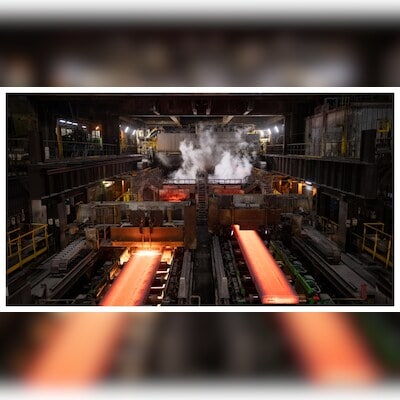)
The infrastructure and construction segment is the biggest end-user of steel. | Photo: Bloomberg
Rising imports, coupled with limited export opportunities and seasonal weakness in demand, are weighing on steel prices.
According to market intelligence and price reporting firm BigMint, hot-rolled coil (HRC) prices have decreased by Rs 1,000 per tonne, now ranging between Rs 47,000-51,000 per tonne. HRC is a benchmark in flat steel.
The trade level represents the lowest point for the current financial year, and the market is showing signs of volatility, marked by a significant decline in demand, an analyst from the firm said.
In long steel, blast furnace (BF) rebar trade prices are currently hovering at Rs 50,000-51,000 per tonne ex-Mumbai, according to BigMint data. Prices hit a three-year low of Rs 49,500 per tonne at the end of August 2024 due to a slowdown in demand.
Rebars have most likely been impacted by the slackening of construction activities during the monsoons. However, major steel producers pointed to an increase in imports, restrictions on export opportunities, and higher production as reasons for the weakness in flat steel prices.
Jayant Acharya, joint managing director and chief executive officer, said, “With a slowdown in the global economy, the global steel industry, including in India, is facing a significant threat due to a surge in steel exports, particularly from China at predatory prices.”
“India is a bright spot in a weaker global demand scenario, with strong domestic demand growing at 13-14 per cent. But it also means that surplus countries are focusing on India to dump their excess material. While our imports have increased sharply, our exports have dropped significantly due to increasing restrictions by various countries,” he added.
Ranjan Dhar, director and vice president of sales and marketing at AM/NS India, echoed that export opportunities for India are constrained, as key markets are either flooded with Chinese exports, experiencing weak demand, or facing trade restrictions. “Meanwhile, imports are surging, even as major producers in India are ramping up production in line with the government’s steel policy.”
Figures from CRISIL Market Intelligence and Analytics (CRISIL MI&A) show that, for the period from April to August, finished steel imports have increased by 24 per cent year-on-year (Y-o-Y), while exports have dipped by 40 per cent Y-o-Y.
The infrastructure and construction segment is the biggest end-user of steel. Post-election, however, tendering and awards activity in India has been mixed.
Manoj Nair, national head of the industrial EPC business at Sterling and Wilson, pointed out that there has been a spike in firm enquiries in the infrastructure and manufacturing space. “Tendering activity has picked up post the general elections, with many requirements coming from mines, metals, ports, electronics, and defence-related sectors. All these are in response to the positive sentiment created towards economic growth through infrastructure development,” he said.
However, ordering activity in the roads segment, a subset of infrastructure, is yet to see a positive spike. A recent ICRA report noted that in the first four months (4M) of FY25, road awards stood at 563 km, 50 per cent lower than the 1,125 km awarded in 4M FY24.
The report stated that, with improved clarity regarding order-awarding activity from the roads ministry in August 2024, project awarding is expected to gain momentum from September 2024 onwards; however, overall project awards will remain substantially lower than the levels seen in FY21-FY23.
Sehul Bhatt, director of research at CRISIL Market Intelligence and Analytics, also pointed to global factors. “Global flat steel prices are at multi-year lows,” he said, adding to the headwinds.
However, he added that the positive side is that lower global prices have curtailed raw material prices as well, such as for iron ore, steel scrap, coking coal, and thermal coal. “This has given steelmakers the leeway to cut prices.”
Low-cost imports have been a concern for steelmakers, especially as major producers are spending billions of dollars on capacity expansion. By 2028, CRISIL MI&A estimates that large steel players will add approximately 50 million tonnes per annum (mtpa) of capacity.
“The Indian steel industry has invested large amounts, and it is important to ensure these investments are not put at risk by unfair dumping from surplus countries,” Acharya pointed out.
Dhar added, “Uncontrolled imports threaten to cripple domestic manufacturing, a concern that the government has acknowledged and is actively working to address.”
The government has launched an anti-dumping probe into imports of hot-rolled (HR) flat products produced in or exported from Vietnam after complaints that they were being sold at low prices.
However, with seasonal weakness behind and the festive season ahead, companies are looking forward to a better second half of the year. “We feel prices have bottomed out, and demand will be strong in the second half of the year with government capex picking up. Festive demand should also lift sentiment,” Acharya said.
First Published: Sep 22 2024 | 2:05 PM IST


